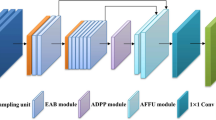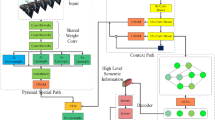Abstract
Semantic segmentation is an advanced research topic in computer vision and can be regarded as a fundamental technique for image understanding and analysis. However, most of the current semantic segmentation networks only focus on segmentation accuracy while ignoring the requirements for high processing speed and low computational complexity in mobile terminal fields such as autonomous driving systems, drone applications, and fingerprint recognition systems. Aiming at the problems that the current semantic segmentation task are facing, it is difficult to meet the actual industrial needs due to its high computational cost. We propose a joint pyramid attention network (JPANet) for real-time semantic segmentation. First, we propose a joint feature pyramid (JFP) module, which can combine multiple network stages with learning multi-scale feature representations with strong semantic information, hence improving pixel classification performance. Second, we built a spatial detail extraction (SDE) module to capture the shallow network multi-level local features and make up for the geometric information lost in the down-sampling stage. Finally, we design a bilateral feature fusion (BFF) module, which properly integrates spatial information and semantic information through a hybrid attention mechanism in spatial dimensions and channel dimensions, making full use of the correspondence between high-level features and low-level features. We conducted a series of experiments on two challenging urban road scene datasets (Cityscapes and CamVid) and achieved excellent results. Among them, the experimental results on the Cityscapes dataset show that for 512 × 1024 high-resolution images, our method achieves 71.62% Mean Intersection over Union (mIoU) with 109.9 frames per second (FPS) on a single 1080Ti GPU.





Similar content being viewed by others
References
Hu X, Jing L (2020) LDPNEt: A lightweight densely connected pyramid network for real-time semantic segmentation. IEEE Access 8:212647–212658
Yu C, Wang J, Gao C, Yu G, Shen C, Sang N (2020) Context prior for scene segmentation. In: Proceedings of the IEEE conference on computer vision and pattern recognition (CVPR), pp 12416–12425
Zhong Z, Lin ZQ, Bidart R, Hu X, Daya IB, Li Z, Zheng W, Li J, Wong A (2020) Squeeze-and-attention networks for semantic segmentation. In: Proceedings of the IEEE conference on computer vision and pattern recognition (CVPR), pp 13065–13074
Li H, Xiong P, Fan H, Sun J (2019) Dfanet: Deep feature aggregation for real-time semantic segmentation. In: Proceedings of the IEEE conference on computer vision and pattern recognition (CVPR), pp 9522–9531
Zhang B, Li W, Hui Y, Liu J, Guan Y (2020) MFENEt: Multi-level feature enhancement network for real-time semantic segmentation. Neurocomputing 393:54–65
Hu P, Perazzi F, Heilbron FC, Wang O, Lin Z, Saenko K, Sclaroff S (2020) Real-time semantic segmentation with fast attention. IEEE Robot Autom Lett 6(1):263–270
Molchanov P, Tyree S, Karras T, Aila T, Kautz J (2017) Pruning convolutional neural networks for resource efficient inference. In: Proceedings of international conference on learning representations (ICLR), pp 1–17
Luo P, Zhu Z, Liu Z, Wang X, Tang X (2016) Face model compression by distilling knowledge from neurons. Proc AAAI Conf Artif Intell (AAAI) 30(1):3560–3566
Denton EL, Zaremba W, Bruna J, LeCun Y, Fergus R (2014) Exploiting linear structure within convolutional networks for efficient evaluation. Adv Neural Inform Process Syst 27:1269–1277
Jiang W, Xie Z, Li Y, Liu C, Lu H (2020) LRNNET: A light-weighted network with efficient reduced non-local operation for real-time semantic segmentation. In: 2020 IEEE international conference on multimedia & expo workshops (ICMEW), pp 1–6
Emara T, Abd El Munim HE, Abbas HM (2019) LiteSeg: A Novel Lightweight ConvNet for Semantic Segmentation. In: 2019 Digital image computing: Techniques and applications (DICTA), pp 1–7
Yu C, Wang J, Peng C, Gao C, Yu G, Sang N (2018) Bisenet: Bilateral segmentation network for real-time semantic segmentation. In: Proceedings of the european conference on computer vision (ECCV), pp 325–341
Orsic M, Kreso I, Bevandic P, Segvic S (2019) In defense of pre-trained imagenet architectures for real-time semantic segmentation of road-driving images. In: Proceedings of the IEEE conference on computer vision and pattern recognition (CVPR), pp 12607–12616
Howard A, Zhu M, Chen B, Kalenichenko D, Wang W, Weyand T, Andreetto M, Adam H (2017) Mobilenets: Efficient convolutional neural networks for mobile vision applications. arXiv:1704.04861
Ma N, Zhang X, Zheng HT, Sun J (2018) Shufflenet v2: Practical guidelines for efficient cnn architecture design. In: Proceedings of the European conference on computer vision (ECCV), pp 116–131
Zhang X, Zhou X, Lin M, Sun J (2018) Shufflenet: An extremely efficient convolutional neural network for mobile devices. In: Proceedings of the IEEE conference on computer vision and pattern recognition (CVPR), pp 6848–6856
Han K, Wang Y, Tian Q, Guo J, Xu C, Xu C (2020) GhostNet: More features from cheap operations. In: Proceedings of the IEEE conference on computer vision and pattern recognition (CVPR), pp 1580–1589
Huang Z, Wang X, Huang L, Huang C, Wei Y, Liu W (2019) Ccnet: Criss-cross attention for semantic segmentation. In: Proceedings of the IEEE international conference on computer vision (ICCV), pp 603–612
Fu J, Liu J, Tian H, Li Y, Bao Y, Fang Z, Lu H (2019) Dual attention network for scene segmentation. In: Proceedings of the IEEE conference on computer vision and pattern recognition (CVPR), pp 3146–3154
Zhou W, Yuan J, Lei J, Luo T (2020) TSNet: three-stream self-attention network for RGB-D indoor semantic segmentation. IEEE Intelligent Systems
Chen L, Papandreou G, Kokkinos I, Murphy K, Yuille AL (2018) Deeplab: Semantic image segmentation with deep convolutional nets, atrous convolution, and fully connected crfs. IEEE Trans Pattern Anal Mach Intell 40(4):834–C848
Chen L, Papandreou G, Schroff F, Adam H (2017) Rethinking atrous convolution for semantic image segmentation. arXiv:1706.05587
Chen L-C, Zhu Y, Papandreou G, Schroff F, Adam H (2018) Encoder-decoder with atrous separable convolution for semantic image segmentation. In: Proceedings of the European conference on computer vision (ECCV), pp 801–C818
Zhao H, Shi J, Qi X, Wang X, Jia J (2017) Pyramid scene parsing network. In: Proceedings of the IEEE conference on computer vision and pattern recognition (CVPR), pp 2881–C2890
Long J, Shelhamer E, Darrell T (2015) Fully convolutional networks for semantic segmentation. In: Proceedings of the IEEE conference on computer vision and pattern recognition (CVPR), pp 3431–C3440
Ronneberger O, Fischer P, Brox T (2015) U-net: Convolutional networks for biomedical image segmentation. In: International conference on medical image computing and computer-assisted intervention, pp 234–241
Yu F, Koltun V (2015) Multi-scale context aggregation by dilated convolutions. arXiv:1511.07122
Woo S, Park J, Lee JY, Kweon IS (2018) Cbam: Convolutional block attention module. In: Proceedings of the European conference on computer vision (ECCV), pp 3–19
Paszke A, Chaurasia A, Kim S, Culurciello E (2016) Enet: A deep neural network architecture for real-time semantic segmentation. arXiv:1606.02147
Badrinarayanan V, Kendall A, Cipolla R (2017) Segnet: a deep convolutional encoder-decoder architecture for image segmentation. IEEE Trans Pattern Anal Mach Intell 39(12):2481–2495
Shrivastava A, Gupta A, Girshick R (2016) Training region-based object detectors with online hard example mining. In: Proceedings of the IEEE conference on computer vision and pattern recognition (CVPR), pp 761–769
Wu H, Zhang J, Huang K, Liang K, Yu Y (2019) Fastfcn: Rethinking dilated convolution in the backbone for semantic segmentation. arXiv:1903.11816
Treml M, Arjona-Medina J, Unterthiner T, Durgesh R, Friedmann F, Schuberth P, Mayr A, Heusel M, Hofmarcher M, Widrich M, Nessler B, Hochreiter S (2016) Speeding up semantic segmentation for autonomous driving. In: MLITS NIPS Workshop 2(7)
Mehta S, Rastegari M, Caspi A, Shapiro L, Hajishirzi H (2018) Espnet: Efficient spatial pyramid of dilated convolutions for semantic segmentation. In: Proceedings of the european conference on computer vision (ECCV), pp 552–568
Yang Z, Yu H, Feng M, Sun W, Lin X, Sun M, Mao Z, Mian A (2020) Small object augmentation of urban scenes for Real-Time semantic segmentation. IEEE Trans Image Process 29:5175–5190
Hu X, Wang H (2020) Efficient fast semantic segmentation using continuous shuffle dilated convolutions. IEEE Access 8:70913–70924
Xiang W, Mao H, Athitsos V (2019) ThunderNet: A turbo unified network for real-time semantic segmentation. In: 2019 IEEE winter conference on applications of computer vision (WACV), pp 1789–1796
Wang J, Xiong H, Wang H, Nian X (2020) ADSCNEt: Asymmetric depthwise separable convolution for semantic segmentation in real-time. Appl Intell 50(4):1045–1056
Chen X, Lou X, Bai L, Han J (2019) Residual pyramid learning for single-shot semantic segmentation. IEEE Trans Intell Transp Syst 21(7):2990–3000
Romera E, Alvarez JM, Bergasa LM, Arroyo R (2017) Erfnet: Efficient residual factorized convnet for real-time semantic segmentation. IEEE Trans Intell Transp Syst 19(1):263–272
Chen PR, Hang HM, Chan SW, Lin JJ (2020) DSNEt: An efficient CNN for road scene segmentation. APSIPA Trans Signa Inform Process 9:1–14
Zhou Q, Wang Y, Fan Y, Wu X, Zhang S, Kang B, Latecki L (2020) AGLNEt: Towards real-time semantic segmentation of self-driving images via attention-guided lightweight network. Appl Soft Comput 96:106682
Zhao H, Qi X, Shen X, Shi J, Jia J (2018) Icnet for real-time semantic segmentation on high-resolution images. In: Proceedings of the European conference on computer vision (ECCV), pp 405–420
Si H, Zhang Z, Lv F, Yu G, Lu F (2019) Real-time semantic segmentation via multiply spatial fusion network. arXiv:1911.07217
Wu T, Tang S, Zhang R, Gao J, Zhang Y (2020) Cgnet: A light-weight context guided network for semantic segmentation. IEEE Trans Image Process 30:1169–1179
Zhang X, Chen Z, Wu QMJ, Cai L, Lu D, Li X (2018) Fast semantic segmentation for scene perception. IEEE Trans Indust Inform 15(2):1183–1192
Lo SY, Hang HM, Chan SW, Lin JJ (2019) Efficient dense modules of asymmetric convolution for real-time semantic segmentation. In: Proceedings of the ACM Multimedia Asia, pp 1–6
Li G, Jiang S, Yun I, Kim J, Kim J (2020) Depth-Wise Asymmetric bottleneck with Point-Wise aggregation decoder for Real-Time semantic segmentation in urban scenes. IEEE Access 8:27495–27506
Author information
Authors and Affiliations
Corresponding author
Additional information
Publisher’s note
Springer Nature remains neutral with regard to jurisdictional claims in published maps and institutional affiliations.
This work was supported by the National Natural Science Foundation of China (under Grant 52076044) and the key project of the Natural Science Foundation of Chongqing, China (under Grant cstc2017jcyjBX0037).
Rights and permissions
About this article
Cite this article
Hu, X., Jing, L. & Sehar, U. Joint pyramid attention network for real-time semantic segmentation of urban scenes. Appl Intell 52, 580–594 (2022). https://doi.org/10.1007/s10489-021-02446-8
Accepted:
Published:
Issue Date:
DOI: https://doi.org/10.1007/s10489-021-02446-8




